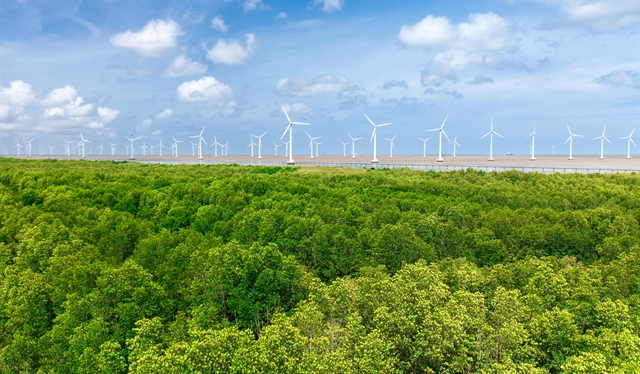 Environment
Environment

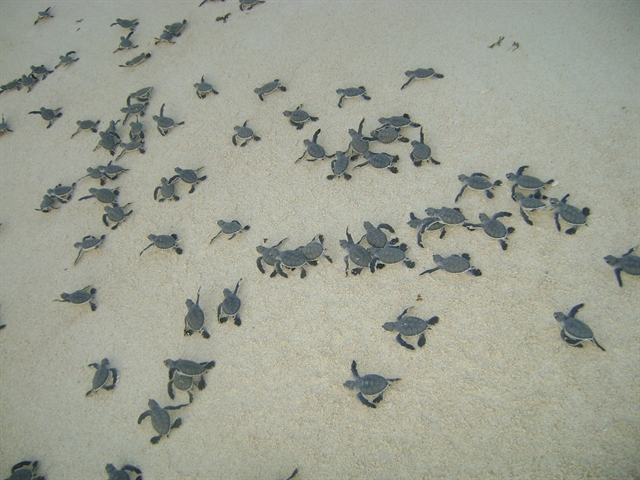
|
| A few days after hatching, baby turtles crawl towards the ocean. VNA/VNS Photo |
BÀ RỊA-VŨNG TÀU — As the breeding season of turtles has started, many green sea turtles (Chelonia mydas) migrate from far-off oceans to their breeding grounds in Côn Đảo archipelago where they mate, lay eggs, and build nests.
Nguyễn Văn Vững, a specialist who has spent years working for the Côn Đảo National Park, said that a green sea turtle takes about two to three hours to build nests and lay eggs.
The turtles usually come to the breeding grounds to lay their eggs when the tide is high. They use their two front flippers to dig the upper part of the nest and their back flippers to dig the lower part of the nest, he said.
The depth of the turtle nest is about 60-70 cm. After finishing digging the nest, the turtle begins to lay eggs (one to four eggs at a time), with a time interval between eggs ranging from 30 seconds to 1 minute.
The average number of eggs per nest is 85, with an average diameter of 5 cm and an average weight of 56 grams each. After a resting period, the mother turtle continues to lay eggs for a second time. On average, each mother turtle lays eggs in three nests per year, with a reproductive cycle of every three years, Vững said.
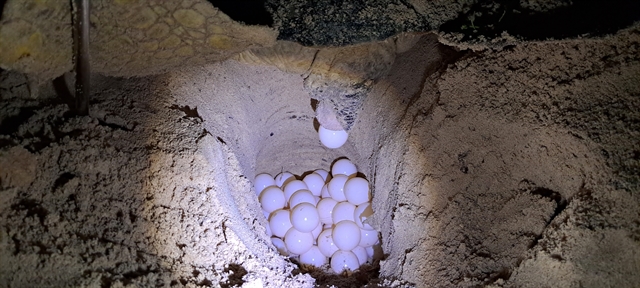
|
| A turtle laying eggs in Bãi Cát Lớn-Hòn Bảy Cạnh in Côn Đảo National Park. VNA/VNS Photo |
Two to three days after hatching, the baby turtles climb onto the beach by themselves mostly at night, when the weather is cool, and the tide is high and crawl towards the ocean in a straight direction, the specialist said.
The turtles swim continuously for one to two days to get as far away from the shore as possible.
Then, the turtles are in the ocean for several years before moving from deep waters to shallow waters with seagrass beds, coral reefs, and mangroves to find food.
After 25-30 years when the turtles reach maturity, they make their first migration to the mating areas where they were born.
After the mating season, the male turtles swim back to foraging areas, and the female turtles come to the beach to lay eggs. After the breeding season, they swim back to the foraging areas. The sea turtle life cycle continues in this way, Vững said.
The waters surrounding Côn Đảo archipelago, off the southern province of Bà Rịa – Vũng Tàu, have recorded four turtle species, namely the green sea turtle (Chelonia mydas), hawksbill sea turtle (Eretmochelys imbricata), olive ridley sea turtle (Lepidochelys olivacea), and loggerhead sea turtle (Caretta caretta).
The number of green sea turtles laying eggs in Côn Đảo is the highest in Việt Nam. Eighteen of the park’s beaches are nesting grounds covering about 24ha, and five of them have seen over 150 turtle arrivals coming to lay eggs annually – Bãi Cát Lớn – Hòn Bảy Cạnh, Bãi Dương – Hòn Bảy Cạnh, Hòn Cau, Hòn Tài and Hòn Tre Lớn.
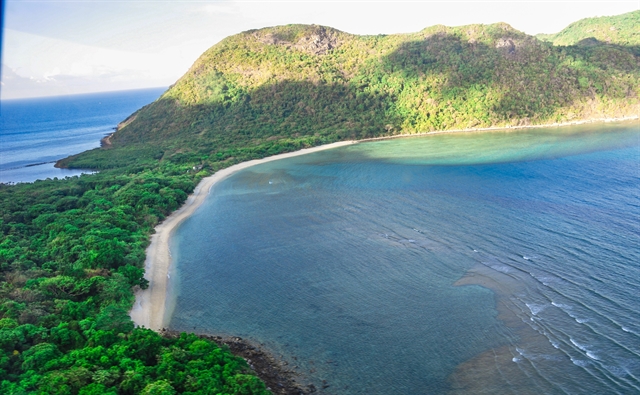
|
| Bãi Cát Lớn-Hòn Bảy Cạnh is one of the breeding grounds for turtles in Côn Đảo. VNA/VNS Photo |
All the species are currently on the brink of extinction and have been named in the Vietnam Red Data Book and the world’s list of threatened species. The country prohibits any hunting, catching, trading, transporting, or using reptile and related products.
Studies by the park’s division for conservation and international cooperation show that the green sea turtle, about 93cm long, 84cm wide and 90kg in weight, nests all year round, with the peak season from May to October.
In the first months of 2023, sea turtles have dug 50 nests to lay eggs in the park. Meanwhile, 134 nests, including those created in late 2022, have hatched. The forest protection force, volunteers, and tourists have released more than 8,000 baby turtles into the sea so far.
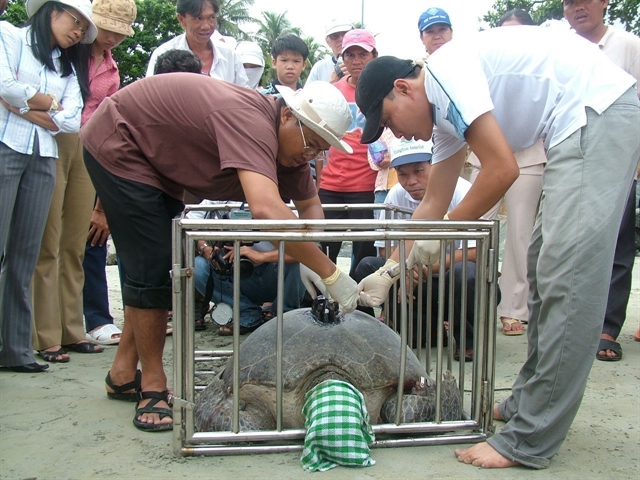
|
| A migration tracker is attached to a turtle. VNA/VNS Photo |
The national park has attached tracking devices to 10 mother animals. Results show that the green sea turtles laying eggs in Côn Đảo travel to search for food in the waters off Phú Quý and Trường Sa (Spratly) of Việt Nam, Palawan Province of the Philippines, Sihanoukville City of Cambodia, Pahang State of Malaysia, and the Natuna Islands of Indonesia.
It has also attached tracking tags to over 5,750 turtles laying eggs in Côn Đảo to monitor their behaviours and morphology. Findings show that each individual digs three nests each breeding season and returns to Côn Đảo to lay eggs every three years. Each nest contains about 90 eggs which will hatch after about 55 days.
Here in the park, the forest protection force goes on patrol to protect the 18 nesting beaches every night, when turtles often come to lay eggs. They have also cleaned the beaches regularly to create conditions for nesting.
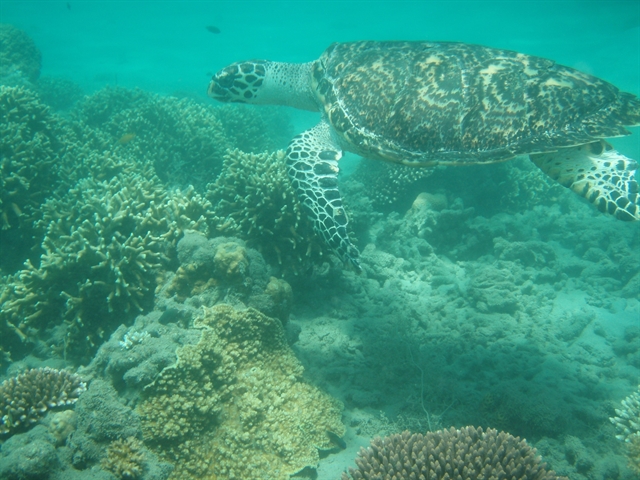
|
| Hawksbill sea turtle (Eretmochelys imbricata) in Côn Đảo. VNA/VNS Photo |
After being laid, all the eggs will be moved to a designated site to avoid adverse human and natural impacts and ensure a high hatching rate.
The Côn Đảo National Park was the first place in Việt Nam to have successfully carried out a sea turtle conservation programme. It records about 450 coming to lay eggs and over 150,000 baby animals released to the wild each year.
In January 2009, it was recognised as the place hatching and releasing the biggest number of baby turtles to the sea in Việt Nam.
From 1993 to 2022, 11,643 turtles came to the park’s beaches to lay eggs. As many as 31,400 nests with 2,898,640 eggs were saved and successfully hatched while 2,238,597 baby turtles were released to nature. The rate of hatched and released animals surpassed 80 per cent, according to statistics from the Côn Đảo National Park. VNS




.jpg)